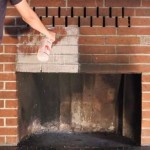How to Clean a Brick Fireplace Hearth
A brick fireplace hearth adds a touch of rustic charm to any room. However, its porous nature and constant exposure to soot, ash, and creosote from burning wood make it susceptible to stubborn stains and discoloration. Regular cleaning is essential to maintain the hearth's aesthetic appeal and prevent the buildup of potentially hazardous substances.
The process of cleaning a brick fireplace hearth involves several steps, from preparation to the final rinse. The specific methods and cleaning solutions used will vary depending on the type and severity of the stains present. This article outlines a comprehensive approach to cleaning a brick fireplace hearth, covering various techniques and addressing common challenges.
Preparation is Key: Gathering Supplies and Protecting Surroundings
Before commencing the cleaning process, gathering the necessary supplies is crucial. The following items should be readily available:
- Protective Gear: Rubber gloves, eye protection (goggles), and a dust mask are essential to protect skin, eyes, and respiratory system from potentially irritating cleaning solutions and loose debris.
- Cleaning Solutions: Several options are available, ranging from mild to strong. These include:
- Dish soap and warm water: A gentle solution for light soiling.
- Baking soda paste: Effective for absorbing stains.
- Vinegar and water solution: Helps to dissolve mineral deposits and soot.
- Commercial brick cleaner: Formulated specifically for masonry, follow manufacturer's instructions carefully.
- Trisodium Phosphate (TSP): A powerful cleaner for stubborn stains and heavy grime, use with extreme caution and proper ventilation.
- Tools: A variety of tools will aid in the cleaning process:
- Stiff-bristled brush: For scrubbing the brick surface.
- Soft-bristled brush: For gentler cleaning and detail work.
- Sponge: For wiping and rinsing.
- Spray bottle: For applying cleaning solutions.
- Scraper: For removing hardened debris.
- Buckets: For holding clean water and cleaning solutions.
- Drop cloths or plastic sheeting: To protect the floor and surrounding areas from splashes and spills.
Protecting the surrounding area is equally important. Lay down drop cloths or plastic sheeting to cover the floor and any nearby furniture. This will prevent staining or damage from cleaning solutions and dislodged soot. Consider taping the edges of the drop cloths to ensure they stay in place. Open windows to provide adequate ventilation, especially when using stronger cleaning agents.
Finally, carefully inspect the hearth to identify the types of stains present. This will help determine the most appropriate cleaning solution and method to use. Note any areas with particularly heavy staining or discoloration.
Cleaning Methods: Addressing Different Stain Types
The cleaning method will depend on the severity and type of stains present. Start with the gentlest method and gradually increase the intensity as needed.
1. Basic Cleaning with Soap and Water: For light soiling and regular maintenance, a simple solution of dish soap and warm water can be effective. Mix a small amount of dish soap with warm water in a bucket. Dip the stiff-bristled brush into the solution and scrub the brick surface thoroughly. Pay attention to any areas with visible dirt or grime. Rinse the hearth with clean water using a sponge and allow it to air dry.
2. Baking Soda Paste for Stain Absorption: Baking soda is a mild abrasive and absorbent agent. It can be used to draw out stains from the porous brick. Create a paste by mixing baking soda with water until it forms a thick consistency. Apply the paste to the stained areas and allow it to sit for several hours or overnight. The baking soda will absorb the stain. Scrape off the dried paste with a scraper and then scrub the area with a damp sponge. Rinse thoroughly with clean water.
3. Vinegar Solution for Mineral Deposits and Soot: A solution of vinegar and water can help dissolve mineral deposits and soot. Mix equal parts white vinegar and water in a spray bottle. Spray the solution onto the affected areas and let it sit for 10-15 minutes. Scrub the brick with a stiff-bristled brush and rinse with clean water. Be cautious when using vinegar on certain types of stone, as it can etch the surface. Always test in an inconspicuous area first.
4. Commercial Brick Cleaner for Stubborn Stains: For more stubborn stains, a commercial brick cleaner may be necessary. These cleaners are specifically formulated to remove dirt, grime, and soot from masonry surfaces. Always follow the manufacturer's instructions carefully when using a commercial brick cleaner. Wear appropriate protective gear and ensure adequate ventilation. Apply the cleaner to the hearth, let it sit for the recommended time, scrub with a stiff-bristled brush, and rinse thoroughly with clean water.
5. Trisodium Phosphate (TSP) for Heavy Grime (Use with Extreme Caution): TSP is a powerful cleaning agent that can effectively remove heavy grime and stubborn stains. However, it is also caustic and can be harmful if not used properly. Wear rubber gloves, eye protection, and a dust mask when using TSP. Ensure adequate ventilation. Mix TSP with water according to the manufacturer's instructions. Apply the solution to the affected areas and let it sit for a few minutes. Scrub the brick with a stiff-bristled brush and rinse thoroughly with clean water. TSP can etch some surfaces, so it's important to test a small, hidden area first. Dispose of the used TSP solution properly.
Important Note: Always test any cleaning solution in an inconspicuous area of the hearth before applying it to the entire surface. This will help ensure that the solution does not damage or discolor the brick. Start with the gentlest cleaning method and gradually increase the intensity as needed. Avoid using abrasive cleaners or tools that could scratch the brick surface.
Addressing Specific Challenges: Soot, Efflorescence, and Smoke Odor
Cleaning a brick fireplace hearth can present specific challenges, such as removing stubborn soot, dealing with efflorescence, and eliminating smoke odor.
Removing Soot: Soot is a common byproduct of burning wood and can be difficult to remove from porous brick. Start by dry brushing the hearth with a stiff-bristled brush to remove loose soot. Vacuum the area to remove any remaining loose particles. Next, use a cleaning solution specifically designed for removing soot, such as a commercial soot remover or a solution of TSP and water. Apply the solution to the affected areas, let it sit for the recommended time, scrub with a stiff-bristled brush, and rinse thoroughly with clean water. Repeat the process as needed. For stubborn soot stains, consider using a poultice made of baking soda and water or a commercial poultice designed for removing soot.
Dealing with Efflorescence: Efflorescence is a white, powdery deposit that can appear on brick surfaces. It is caused by water-soluble salts that migrate to the surface and crystallize. To remove efflorescence, start by dry brushing the affected area with a stiff-bristled brush. Vacuum the area to remove any loose particles. Next, use a solution of water and muriatic acid (hydrochloric acid). Muriatic acid is a strong acid and should be handled with extreme caution. Wear rubber gloves, eye protection, and a dust mask when using muriatic acid. Ensure adequate ventilation. Mix the muriatic acid with water according to the manufacturer's instructions (typically a 1:10 ratio). Apply the solution to the affected areas and let it sit for a few minutes. Scrub the brick with a stiff-bristled brush and rinse thoroughly with clean water. Neutralize the acid residue by rinsing the area with a solution of baking soda and water. Prevent future efflorescence by addressing the source of the moisture. This may involve repairing cracks in the brick or improving drainage around the fireplace.
Eliminating Smoke Odor: Smoke odor can linger in the brick hearth even after cleaning. To eliminate smoke odor, try the following:
- Ventilation: Open windows and doors to ventilate the room.
- Baking Soda: Place bowls of baking soda around the room to absorb odors.
- Vinegar: Simmer a pot of vinegar on the stove to neutralize odors.
- Odor Absorbers: Use commercial odor absorbers specifically designed for smoke odors.
- Professional Cleaning: If the smoke odor is persistent, consider hiring a professional cleaning service specializing in smoke damage restoration.
By addressing these specific challenges, a brick fireplace hearth can be thoroughly cleaned and restored to its original beauty.

How To Clean A Fireplace Diy Basics

How To Clean Fireplace Bricks 9 Steps With S Wikihow

How To Clean Brick Fireplaces Mantels Hearths And More My Space

How To Clean Fireplace Bricks Simple Practical Beautiful

How To Clean Brick Fireplace Kitchen Infinity

Fireplace Cleaning Tutorial Kippi At Home

How To Clean Brick Fireplace 2024 Updated Guide

Best Way To Clean A Fireplace Stacy Risenmay

Mortar Wash Brick Fireplace Makeover Dimples And Tangles

How To Clean A Brick Fireplace With Scrubbing Bubbles 2024 Today S Homeowner
Related Posts








